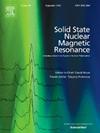利用固态核磁共振阐明昆虫生物材料的结构和新陈代谢。
IF 2.4
3区 化学
Q4 CHEMISTRY, PHYSICAL
引用次数: 0
摘要
在许多天然生物材料中,有关原子级结构和重新定向运动的信息可以提供重要的功能线索,而具有有限有序度的不溶性多组分复合材料则是最具挑战性的研究对象之一。尽管固态核磁共振(ssNMR)的灵敏度有限,但它往往是在富碳和富氮材料中探寻这些细节的首选技术:这种光谱方法可以在引入或不引入稳定核磁共振活性同位素的情况下,或在动态核偏振技术的帮助下,探测许多生物材料的原生态或接近原生态的状态。在近四十年的时间里,昆虫是此类研究目标和 ssNMR 方法的典范,昆虫是一个多样化、进化敏捷的生物群体,对生态学、农业和人类疾病具有全球性影响。在这篇简短的综述中,我们将介绍有关昆虫角质层的案例研究,这些角质层包括保护性外骨骼和卵囊,以及使昆虫能够飞行并展示大自然令人惊叹之美的翅膀结构,重点介绍如何使用ssNMR 光谱分析化学成分、阐明大分子结构,以及监测这些迷人的生物组合体的新陈代谢发展。本文章由计算机程序翻译,如有差异,请以英文原文为准。
Elucidating structure and metabolism of insect biomaterials by solid-state NMR
Among the many natural biomaterials for which information on atomic-level structure and reorientational motion can offer essential clues to function, insoluble multi-component composites with limited degrees of order are among the most challenging to study. Despite its limited sensitivity, solid-state NMR (ssNMR) is often the technique of choice to ferret out these details in carbon- and nitrogen-rich materials: this spectroscopic approach can probe many biomaterials in their native or near-native states, either with or without the introduction of stable NMR-active isotopes, or with the assistance of dynamic nuclear polarization technology. During a span of close to four decades, such research targets and ssNMR approaches have been exemplified by insects, a diverse and evolutionarily agile group of organisms with global impacts that include ecology, agriculture, and human disease. In this short review, we present case studies on insect cuticles that range from protective exoskeletons and egg capsules to the wing structures that enable flight and showcase nature's awe-inspiring beauty, highlighting the use of ssNMR spectroscopy to profile chemical composition, elucidate macromolecular architecture, and monitor metabolic development in these fascinating biological assemblies.
求助全文
通过发布文献求助,成功后即可免费获取论文全文。
去求助
来源期刊
CiteScore
5.30
自引率
9.40%
发文量
42
审稿时长
72 days
期刊介绍:
The journal Solid State Nuclear Magnetic Resonance publishes original manuscripts of high scientific quality dealing with all experimental and theoretical aspects of solid state NMR. This includes advances in instrumentation, development of new experimental techniques and methodology, new theoretical insights, new data processing and simulation methods, and original applications of established or novel methods to scientific problems.

 求助内容:
求助内容: 应助结果提醒方式:
应助结果提醒方式:


